Equilateral Dispersive Prisms

- High Refractive Index
- Low Abbe Vd Number for Maximum Dispersion
- Material: F2, N-F2, N-SF11, CaF2, or ZnSe
PS854
PS860
PS856
PS861
Application Idea
PS855 Prism on a KM200B
Platform Mount

Please Wait
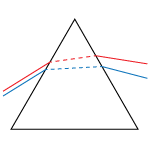
Figure 1.1 Top-Down Diagram of Dispersive Prism with Two Incident Rays
Our Dispersive Equilateral Prisms, which are fabricated from F2, N-F2, N-SF11, CaF2, or ZnSe are available in sizes ranging from 10 mm to 50 mm. These prisms create less stray light than diffraction gratings, thereby eliminating the higher order problems typically associated with gratings.
Dispersive prisms are typically used at the minimum angle of deviation. This is the angle for which the wavelength of interest will travel parallel to the base of the prism, and the angle of incidence is equal to the angle of refraction when measured with respect to the normal of the prism face at the respective interface (see the Equilateral Tutorial tab for more information). At the minimum angle of deviation, a maximum clear aperture is achieved and reflective loss of p-polarized light is reduced since the angle of incidence is nearly Brewster's angle. For s-polarization, a custom antireflective coating can be used to minimize surface reflections.
Please refer to the Prism Guide tab above for assistance in selecting the appropriate prism for your application, or to view Thorlabs' extensive line of prisms, please click here.
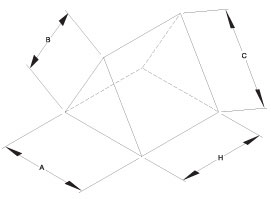
| Item # | A=B=C=H (mm) |
Material | Minimum Angle of Deviation |
Vdb | Surface Flatness @ 633 nm |
|---|---|---|---|---|---|
| PS850 | 10 ± 0.15 | F2 | 47.9° @ 633 nm | 36.37 | λ/10 |
| PS852 | 25 ± 0.15 | ||||
| PS856 | 15 ± 0.15 | N-F2 | 47.9° @ 633 nm | 36.43 | λ/10 |
| PS858 | 20 ± 0.15 | ||||
| PS854 | 50 ± 0.15 | ||||
| PS851 | 10 ± 0.15 | N-SF11a | 65.6° @ 633 nm | 25.76 | λ/10 |
| PS857 | 15 ± 0.15 | ||||
| PS859 | 20 ± 0.15 | ||||
| PS853 | 25 ± 0.15 | ||||
| PS855 | 40 ± 0.15 | ||||
| PS862 | 10 +0.0/-0.3 | CaF2 | 31.6° @ 633 nm | 95.00 | λ/2 |
| PS863 | 25 +0.0/-0.3 | ||||
| PS860 | 10 +0.0/-0.3 | ZnSe | N/A | N/A | λ/2 |
| PS861 | 25 +0.0/-0.3 |
| Material | Wavelength Range | Index of Refraction | Abbe Number |
|---|---|---|---|
| F2 | 385 nm - 2 µm | 1.617 @ 633 nm | 36.37 |
| N-F2 | 420 nm - 2 µm | 1.617 @ 633 nm | 36.43 |
| N-SF11 | 420 nm - 2.3 µm | 1.779 @ 633 nm | 25.76 |
| CaF2 | 180 nm - 8 µm | 1.433 @ 633 nm | 95.00 |
| ZnSe | 600 nm - 16 µm | 2.403 @ 10.6 µm | N/Aa |
N-SF11, F2, and N-F2
Both N-SF11 and F2 offer excellent performance in the visible range. When compared to each other, F2, which is a flint glass, has superior chemical resistance and better transmission than N-SF11. For instance, at 420 nm the theoretical internal transmittance of a 10 mm thick piece of F2 is 0.995, whereas for the same thickness of N-SF11, the internal transmittance is 0.910. If the glass is increased to a thickness of 25 mm, these internal transmission values decrease to 0.987 and 0.790, respectively. With high indices of refraction and low Abbe Numbers Vd, N-SF11 and F2 provide maximum dispersive power.
N-F2 is a RoHS compliant material that has been engineered to have nearly identical optical properties as F2. At 633 nm, both N-F2 and F2 have an index of refraction of 1.617, and they have nearly identical Abbe numbers of 36.43 and 36.37, respectively.
Calcium Fluoride
CaF2 is commonly used for applications requiring high transmission in the infrared and ultraviolet spectral ranges. The material exhibits a low refractive index, varying from 1.35 to 1.51 within its usage range of 180 nm to 8.0 µm, as well as an extremely high laser damage threshold. Calcium fluoride is also fairly chemically inert and offers superior hardness compared to its barium fluoride, magnesium fluoride, and lithium fluoride cousins.
Zine Selenide
Zinc Selenide is ideal for use in the 600 nm to 16 µm wavelength range. It features low absorption (including in the red visible wavelength range) and high resistance to thermal shock. ZnSe is ideal for use in CO2 laser systems operating at 10.6 µm, including those with HeNe alignment lasers. Please note that, due to its low hardness, care should be taken when handling ZnSe optics.
The index of refraction of various materials can be calculated via the Sellmeier equation. Each material is empirically assigned a set of coefficients, through which the index of refraction can be calculated at any wavelengtha.
Sellmeier Equation: ![]()
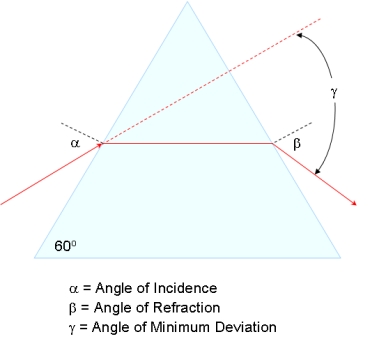
Angle of Minimum Deviation Through a Prism
If one were to use ray tracing techniques to determine the light propagation path due to the presence of the equilateral prism shown in Figure 5.1, you would find that for most incidence angles, the angle of deviation of the transmitted ray (denoted by γ in the figure to the right) is roughly the same, regardless of the angle of incidence ![]() considered. However, although the angle of deviation is largely unchanged, there is a minimum value that is obtainable. This angle is known as the minimum angle of deviation; it occurs when the light ray passing through the prism is parallel to the prism's base (as shown in Figure 5.1), and therefore,
considered. However, although the angle of deviation is largely unchanged, there is a minimum value that is obtainable. This angle is known as the minimum angle of deviation; it occurs when the light ray passing through the prism is parallel to the prism's base (as shown in Figure 5.1), and therefore, ![]() = β (i.e., the angle of the light ray entering the prism is identical to that of the light ray exiting the prism).
= β (i.e., the angle of the light ray entering the prism is identical to that of the light ray exiting the prism).
To illustrate the relationship between the incident, exit, and deviation angles in the triangle in Figure 5.1, consider the equilateral triangle shown in Figure 5.2, which is identical to the one shown to in Figure 5.1 but has several more angles labeled. Using the geometric relationships that exist for vertical angles, it becomes apparent that A = ![]() - θ1 and C = β - θ2. Since the angles A, B, and C define a triangle, we know that A + B + C = 180°, and thus, B = 180° - (A + C) = 180° - [(
- θ1 and C = β - θ2. Since the angles A, B, and C define a triangle, we know that A + B + C = 180°, and thus, B = 180° - (A + C) = 180° - [(![]() - θ1) + (β - θ2)]. Finally, B + γ = 180°, so γ = 180° - B = [(
- θ1) + (β - θ2)]. Finally, B + γ = 180°, so γ = 180° - B = [(![]() - θ1) + (β - θ2)].
- θ1) + (β - θ2)].
Now, consider the triangle outlined in green in Figure 5.2. Here, (90 - θ1) + (90 - θ2) + 60° = 180°. Thus, θ1 + θ2 = 60°. Substituting this relationship into the end result derived in the previous paragraph, yields γ = ![]() + β - (θ1 + θ2) =
+ β - (θ1 + θ2) = ![]() + β - 60°.
+ β - 60°.
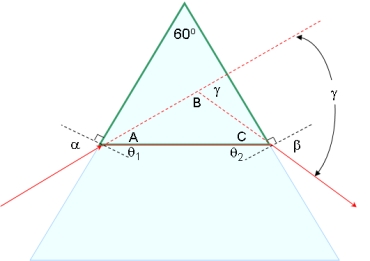
For the angle of minimum deviation, ![]() = β, so there is a simple relationship between the angle of incidence and the angle of minimum deviation:
= β, so there is a simple relationship between the angle of incidence and the angle of minimum deviation:
γ = ![]() + β - 60° = 2
+ β - 60° = 2![]() - 60°
- 60°
By applying Snell's Law to the interfaces of prism and using a little calculus, a general equation for the relationship between the index of refraction of the equilateral prism n and the angle of minimum deviation γ can be obtained:

At the design wavelength (633 nm), the indices of refraction for N-SF11 and F2 are 1.779 and 1.617, respectively. Solving for γ in the equation above yields 65.6° for N-SF11 and 47.9° for F2.
This equation can be used for prisms with n < 2.0; if the refractive index is higher, this geometry will cause total internal reflection at angle C above. ZnSe dispersive prisms, like the PS860 and PS861 prisms sold below, will have a beam exiting from the bottom face of the prism.
| Posted Comments: | |
Martin Abrhan
(posted 2025-03-05 07:32:47.18) Dear Sir,
I am interested in N-SF11 Equilateral Dispersive Prism with larger dimensions than this one (40mm).
Could you also make me 100x100x100mm for example? What is the maximum size you can produce?
Thank you,
Martin Abrhan EGies
(posted 2025-03-10 04:39:39.0) Thank you for contacting Thorlabs. I have reached out to you directly regarding the feasibility of this custom request. user
(posted 2023-02-15 15:39:10.96) Hi, I want to double-check that the reflectivity graph provided for N-F2 is meant just the interface air/prism or does it include the interface prism/air? Many thanks. cdolbashian
(posted 2023-02-17 02:16:37.0) Thank you for reaching out to us with this inquiry. The reflectivity graph is specified for the air-glass interface at 633nm at ~47.9° AOI. dsablowski
(posted 2018-04-10 09:41:23.45) Hi,
are the F2 prisms really made from F2 or N-F2 glass? Quite important for transmission in the blue. YLohia
(posted 2018-04-10 08:57:06.0) Hello, thank you for contacting Thorlabs. Some of these prisms are made of F2 while others are made of N-F2. We will update our web presentation of these products to reflect this information more clearly. user
(posted 2015-05-16 21:40:54.12) You used to list the dispersion of the prisms, i.e. \delta\lambda/\delta\theta [nm/mrad] @ \lambda_0 = ... This is really useful information to gauge the approximate dispersion of each prism. myanakas
(posted 2015-08-10 04:42:51.0) Response from Mike at Thorlabs: Thank you for your feedback. Our “Equilateral Tutorial” tab and “index of refraction” tab should explain what is needed to obtain this information. Since no contact information was left, we were not able to contact you directly. Please contact TechSupport@Thorlabs.com if more information or help is needed. user
(posted 2014-09-30 01:56:15.903) How to use ZnSe or Ge Equilateral Dispersive Prisms? Due to high index of refraction it cannot be used at the minimum angle of deviation.
What are the typical usage and configuration of these Prisms? jlow
(posted 2014-10-08 02:16:38.0) Response from Jeremy at Thorlabs: Because of the high refractive index, light that enters the prism will undergo total internal reflection and exits out of the bottom face. sharrell
(posted 2012-02-28 08:10:00.0) A Response from Sean at Thorlabs to mathiew.perrin: Thank you again for your feedback. We have updated the catalog page attached to our website-you were correct that these values were the minimum deviation angle. We will add more information to our website in the near future describing the variation of wavelength with angle. bdada
(posted 2012-02-24 09:55:00.0) Response from Buki at Thorlabs to mathieu.perrin:
Thank you for pointing out the error. We will correct our website shortly and contact you directly with the right information. mathieu.perrin
(posted 2012-02-17 10:47:20.0) I think there is an error in the catalog page: the Dlambda/Dtheta column gives 47.9nm/degree and 65.6nm/degree for F2 and N-SF11. I do not find this after 1h of checking. Additionally, these are the exact same figure as the minimum deviation angle quoted in your Specs tab: 47.9° and 65.6°. So there might have been some unfortunate copy-paste :-). bdada
(posted 2012-01-30 18:56:00.0) Response from Buki at Thorlabs:
Thank you for using our feedback forum. Bot prisms should work for your application. The main difference btween the PS852 and PS853 equilateral prisms is the type of glass, F2 or N-SF11. F2 has better transmission and a smaller minimum angle of deviation. Please review the "Overview" and "Specs" tab on our website for more information.
We have contacted you directly to provide additional assistance. fjmraz
(posted 2012-01-26 16:16:44.0) P852 and P853....Which should I order if I am building a spectroscope for a class ? bdada
(posted 2011-10-12 12:44:00.0) Response from Buki at Thorlabs:
For the N-SF11 glass, the refractive index at 500nm is 1.803 and at 650nm it is 1.777. user
(posted 2011-10-11 18:00:15.0) I am interested in the refractive indices of N-SF11 around 500 nm and 650 nm. Could you provide me with information about the refractive index?Thank You. jjurado
(posted 2011-05-24 11:57:00.0) Response from Javier at Thorlabs to kalle.o.koskinen: Thank you very much for contacting us with your request. The refractive indices of F2 and N-SF11 at 800 nm and 1600 nm are as follows: F2: 1.60839 at 800 nm, 1.59425 at 1600 nm. N-SF11: 1.76462 at 800 nm, 1.74251 at 1600 nm. Below is a link for a great online resource for getting the refractive indices of various materials at different wavelengths: www.refractiveindex.info. kalle.o.koskinen
(posted 2011-05-24 08:12:47.0) Could you provide me with information about the refractive index as a function of wavelength for your F2 and N-SF11 prism materials. I am interested in the refractive indices around 1600 nm and 800 nm. Thank You. klee
(posted 2009-10-29 16:47:18.0) A response from Ken at Thorlabs to ferraman: We should be able to make quartz dispersion prisms. However, we will need to know the quantity and the dimensions. Please send an email to techsupport@thorlabs.com with the dimensions (a drawing will even be better) and the quantity so we can work on a quote. ferraman
(posted 2009-10-29 07:23:08.0) Dear Sirs,
Im very interested in quartz dispersion prism.
Could I buy these prism from thorlabs?
Thanks in advance.
Fernando Tyler
(posted 2009-03-16 07:26:24.0) A response from Tyler at Thorlabs to kevin.lim: Thank you for double checking this specification with us. The actual tolerance is +/- 0.15 mm for the 10 mm prisms and +/- 0.1 mm for all the rest. It is difficult for us to find this type of mistake on our webpage so we really appreciate the fact that you took the time to drop us a note. The webpage has been corrected. kevin.lim
(posted 2009-03-16 02:20:35.0) Hello,
Just to double confirm, is the dimentional tolorence: ±15 mm or is there a typo on the unit?
Thanks,
Kevin |
Selection Guide for Prisms
Thorlabs offers a wide variety of prisms, which can be used to reflect, invert, rotate, disperse, steer, and collimate light. For prisms and substrates not listed below, please contact Tech Support.
Beam Steering Prisms
| Prism | Material | Deviation | Invert | Reverse or Rotate | Illustration | Applications |
|---|---|---|---|---|---|---|
| Right Angle Prisms | N-BK7, UV Fused Silica, Calcium Fluoride, or Zinc Selenide | 90° | 90° | No | 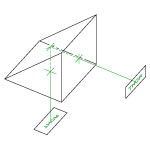 |
90° reflector used in optical systems such as telescopes and periscopes. |
| 180° | 180° | No | 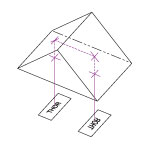 |
180° reflector, independent of entrance beam angle. Acts as a non-reversing mirror and can be used in binocular configurations. |
||
| TIR Retroreflectors (Unmounted and Mounted) and Specular Retroreflectors (Unmounted and Mounted) |
N-BK7 | 180° | 180° | No | 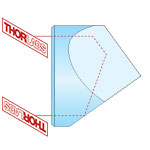 |
180° reflector, independent of entrance beam angle. Beam alignment and beam delivery. Substitute for mirror in applications where orientation is difficult to control. |
| Unmounted Penta Prisms and Mounted Penta Prisms |
N-BK7 | 90° | No | No | 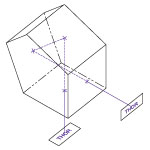 |
90° reflector, without inversion or reversal of the beam profile. Can be used for alignment and optical tooling. |
| Roof Prisms | N-BK7 | 90° | 90° | 180o Rotation | 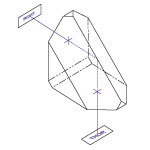 |
90° reflector, inverted and rotated (deflected left to right and top to bottom). Can be used for alignment and optical tooling. |
| Unmounted Dove Prisms and Mounted Dove Prisms |
N-BK7 | No | 180° | 2x Prism Rotation | 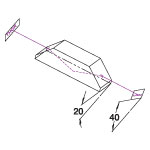 |
Dove prisms may invert, reverse, or rotate an image based on which face the light is incident on. Prism in a beam rotator orientation. |
| 180° | 180° | No | 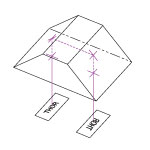 |
Prism acts as a non-reversing mirror. Same properties as a retroreflector or right angle (180° orientation) prism in an optical setup. |
||
| Wedge Prisms | N-BK7 | Models Available from 2° to 10° | No | No |  |
Beam steering applications. By rotating one wedged prism, light can be steered to trace the circle defined by 2 times the specified deviation angle. |
| No | No |  |
Variable beam steering applications. When both wedges are rotated, the beam can be moved anywhere within the circle defined by 4 times the specified deviation angle. |
|||
| Coupling Prisms | Rutile (TiO2) or GGG | Variablea | No | No | 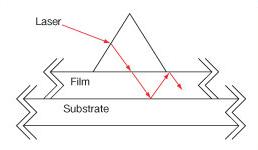 |
High index of refraction substrate used to couple light into films. Rutile used for nfilm > 1.8 GGG used for nfilm < 1.8 |
Dispersive Prisms
| Prism | Material | Deviation | Invert | Reverse or Rotate | Illustration | Applications |
|---|---|---|---|---|---|---|
| Equilateral Prisms | F2, N-F2, N-SF11, Calcium Fluoride, or Zinc Selenide |
Variablea | No | No |  |
Dispersion prisms are a substitute for diffraction gratings. Use to separate white light into visible spectrum. |
| Dispersion Compensating Prism Pairs | Fused Silica, Calcium Fluoride, SF10, or N-SF14 | Variable Vertical Offset | No | No |  |
Compensate for pulse broadening effects in ultrafast laser systems. Can be used as an optical filter, for wavelength tuning, or dispersion compensation.
|
| Pellin Broca Prisms | N-BK7, UV Fused Silica, or Calcium Fluoride |
90° | 90° | No | 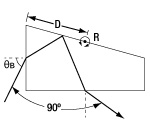 |
Ideal for wavelength separation of a beam of light, output at 90°. Used to separate harmonics of a laser or compensate for group velocity dispersion. |
Beam Manipulating Prisms
| Prism | Material | Deviation | Invert | Reverse or Rotate | Illustration | Applications |
|---|---|---|---|---|---|---|
| Anamorphic Prism Pairs | N-KZFS8 or N-SF11 |
Variable Vertical Offset | No | No | 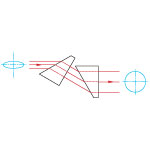 |
Variable magnification along one axis. Collimating elliptical beams (e.g., laser diodes) Converts an elliptical beam into a circular beam by magnifying or contracting the input beam in one axis. |
| Axicons (UVFS, ZnSe) | UV Fused Silica or Zinc Selenide |
Variablea | No | No |
Creates a conical, non-diverging beam with a Bessel intensity profile from a collimated source. |
Polarization Altering Prisms
| Prism | Material | Deviation | Invert | Reverse or Rotate | Illustration | Applications |
|---|---|---|---|---|---|---|
| Glan-Taylor, Glan-Laser, and α-BBO Glan-Laser Polarizers | Glan-Taylor: Calcite Glan-Laser: α-BBO or Calcite |
p-pol. - 0° s-pol. - 112°a |
No | No |  |
Double prism configuration and birefringent calcite produce extremely pure linearly polarized light. Total Internal Reflection of s-pol. at the gap between the prism while p-pol. is transmitted. |
| Rutile Polarizers | Rutile (TiO2) | s-pol. - 0° p-pol. absorbed by housing |
No | No | 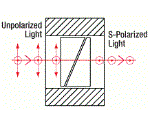 |
Double prism configuration and birefringent rutile (TiO2) produce extremely pure linearly polarized light. Total Internal Reflection of p-pol. at the gap between the prisms while s-pol. is transmitted.
|
| Double Glan-Taylor Polarizers | Calcite | p-pol. - 0° s-pol. absorbed by housing |
No | No | 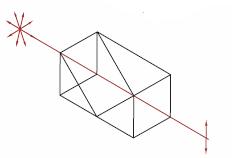 |
Triple prism configuration and birefringent calcite produce maximum polarized field over a large half angle. Total Internal Reflection of s-pol. at the gap between the prism while p-pol. is transmitted. |
| Glan Thompson Polarizers | Calcite | p-pol. - 0° s-pol. absorbed by housing |
No | No | 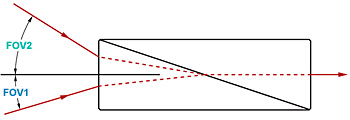 |
Double prism configuration and birefringent calcite produce a polarizer with the widest field of view while maintaining a high extinction ratio. Total Internal Reflection of s-pol. at the gap between the prism while p-pol. is transmitted. |
| Wollaston Prisms and Wollaston Polarizers |
Quartz, Magnesium Fluoride, α-BBO, Calcite, Yttrium Orthovanadate | Symmetric p-pol. and s-pol. deviation angle |
No | No | 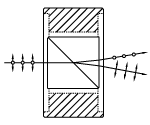 |
Double prism configuration and birefringent calcite produce the widest deviation angle of beam displacing polarizers. s-pol. and p-pol. deviate symmetrically from the prism. Wollaston prisms are used in spectrometers and polarization analyzers. |
| Rochon Prisms | Magnesium Fluoride or Yttrium Orthovanadate |
Ordinary Ray: 0° Extraordinary Ray: deviation angle |
No | No | 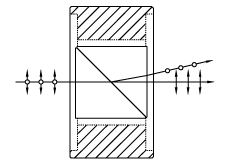 |
Double prism configuration and birefringent MgF2 or YVO4 produce a small deviation angle with a high extinction ratio. Extraordinary ray deviates from the input beam's optical axis, while ordinary ray does not deviate. |
| Beam Displacing Prisms | Calcite | 2.7 or 4.0 mm Beam Displacement | No | No | 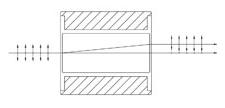 |
Single prism configuration and birefringent calcite separate an input beam into two orthogonally polarized output beams. s-pol. and p-pol. are displaced by 2.7 or 4.0 mm. Beam displacing prisms can be used as polarizing beamsplitters where 90o separation is not possible. |
| Fresnel Rhomb Retarders | N-BK7 | Linear to circular polarization Vertical Offset |
No | No | 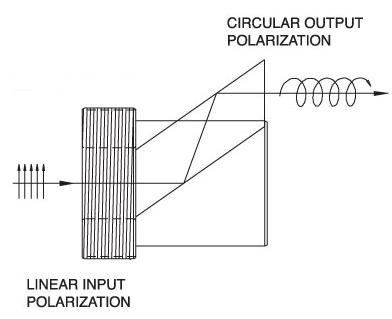 |
λ/4 Fresnel Rhomb Retarder turns a linear input into circularly polarized output. Uniform λ/4 retardance over a wider wavelength range compared to birefringent wave plates. |
| Rotates linearly polarized light 90° | No | No | 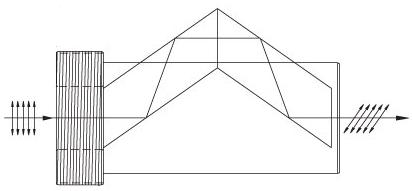 |
λ/2 Fresnel Rhomb Retarder rotates linearly polarized light 90°. Uniform λ/2 retardance over a wider wavelength range compared to birefringent wave plates. |
Beamsplitter Prisms
| Prism | Material | Deviation | Invert | Reverse or Rotate | Illustration | Applications |
|---|---|---|---|---|---|---|
| Beamsplitter Cubes | N-BK7 | 50:50 splitting ratio, 0° and 90° s- and p- pol. within 10% of each other |
No | No |  |
Double prism configuration and dielectric coating provide 50:50 beamsplitting nearly independent of polarization. Non-polarizing beamsplitter over the specified wavelength range. |
| Polarizing Beamsplitter Cubes | N-BK7, UV Fused Silica, or N-SF1 | p-pol. - 0° s-pol. - 90° |
No | No | 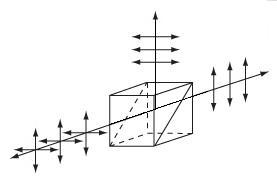 |
Double prism configuration and dielectric coating transmit p-pol. light and reflect s-pol. light. For highest polarization use the transmitted beam. |


Click to Enlarge
Download an Excel File with Raw Transmission Data
Figure G1.2 Transmission data is for a 10 mm thick sample.
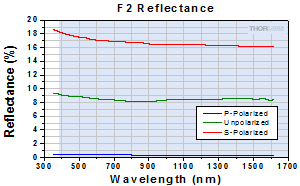
Click to Enlarge
Figure G1.1 This graph shows the polarization-dependent reflectance of F2 glass.
F2 is a flint glass that offers excellent performance in the visible and NIR spectral range. It offers a high refractive index and low Abbe number, making it excellent for use in an equilateral dispersive prism. Compared to N-SF11, it offers superior chemical resistance and slightly higher transmission.
Polarization Effects
For p-polarized light (blue line) incident on a dispersing prism at the angle of least deviation, Figure G1.1 shows that only a small percentage of the p-polarized light is reflected at the surface. Thus, for this polarization, the transmission through a prism fabricated from F2 will be excellent even though there is no AR coating on the surface.
| Material | Minimum Angle of Deviation |
Vdb | Surface Flatness @ 633 nm |
Clear Aperture |
Surface Quality |
Angular Tolerance |
Number of Polished Faces |
Index of Refraction Plot |
|---|---|---|---|---|---|---|---|---|
| F2a | 47.9° @ 633 nm | 36.37 | λ/10 | 70% | 40-20 Scratch-Dig | ±5 arcmin | 2c |

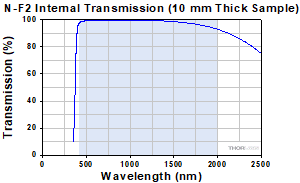
Click to Enlarge
Download an Excel File with Raw Transmission Data
Figure G2.2 Transmission data is for a 10 mm thick sample.
N-F2 is a RoHS compliant material that has been engineered to have nearly identical optical properties as F2. Like F2, it is a flint glass that offers excellent performance in the visible and NIR spectral range. It offers a high refractive index and low Abbe number, making it excellent for use in an equilateral dispersive prism.
Polarization Effects
For p-polarized light (blue line) incident on a dispersing prism at the angle of least deviation, Figure G2.1 shows that only a small percentage of the p-polarized light is reflected at the surface. Thus, for this polarization, the transmission through a prism fabricated from N-F2 will be excellent even though there is no AR coating on the surface.
| Material | Minimum Angle of Deviation |
Vdb | Surface Flatness @ 633 nm |
Clear Aperture |
Surface Quality |
Angular Tolerance |
Number of Polished Faces |
Index of Refraction Plot |
|---|---|---|---|---|---|---|---|---|
| N-F2a | 47.9° @ 633 nm | 36.43 | λ/10 | 70% | 40-20 Scratch-Dig | ±5 arcmin | 2c |

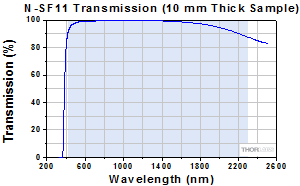 Click to Enlarge
Click to EnlargeDownload an Excel File with Raw Transmission Data
Figure G3.2 Transmission data is for a 10 mm thick sample.
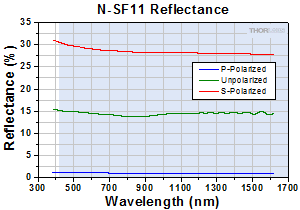 Click to Enlarge
Click to EnlargeFigure G3.1 This graph shows the polarization-dependent reflectance of N-SF11 glass.
N-SF11 is a flint glass that offers excellent performance in the visible and NIR spectral range. It offers a high refractive index and low Abbe number, making it excellent for use in an equilateral dispersive prism.
Polarization Effects
For p-polarized light (blue line) incident on a dispersing prism at the angle of least deviation, Figure G3.1 shows that only a small percentage of the p-polarized light is reflected at the surface. Thus, for this polarization, the transmission through a prism fabricated from N-SF11, a RoHS-compliant version of SF11, will be excellent even though there is no AR coating on the surface.
| Material | Minimum Angle of Deviation |
Vdb | Surface Flatness @ 633 nm |
Clear Aperture |
Surface Quality |
Angular Tolerance |
Number of Polished Faces |
Index of Refraction Plot |
|---|---|---|---|---|---|---|---|---|
| N-SF11a | 65.5° @ 633 nm | 24.76 | λ/10 | 70% | 40-20 Scratch-Dig | ±5 arcmin | 2c |

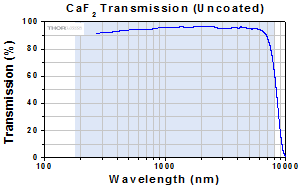
Click to Enlarge
Download an Excel File with Raw Transmission Data
Figure G4.1 Transmission data is for two 25 mm right-angle prisms contacted into a cube.
CaF2 is commonly used for applications requiring high transmission in the infrared and ultraviolet spectral ranges. The material exhibits a low refractive index, varying from 1.35 to 1.51 within its usage range of 180 nm to 8.0 µm, as well as an extremely high laser damage threshold. Calcium fluoride is also fairly chemically inert and offers superior hardness compared to its barium fluoride, magnesium fluoride, and lithium fluoride cousins.
| Material | Minimum Angle of Deviation |
Vdb | Surface Flatness @ 633 nm |
Clear Aperture |
Surface Quality |
Angular Tolerance |
Number of Polished Faces |
Index of Refraction Plot |
|---|---|---|---|---|---|---|---|---|
| CaF2a | 31.6° @ 633 nm | 95.00 | λ/2 | 70% | 40-20 Scratch-Dig | ±10 arcmin | 2c |

 Click to Enlarge
Click to EnlargeDownload an Excel File with Raw Transmission Data
Figure G5.1 Transmission data is for two 25 mm right-angle prisms contacted into a cube.
Zinc Selenide is ideal for use in the 600 nm to 16 µm range. It features low absorption (including in the red visible wavelength range) and high resistance to thermal shock. ZnSe is ideal for use in CO2 laser systems operating at 10.6 µm, including those with HeNe alignment lasers. Note that due to their high refractive index, these prisms can not be used in the traditional orienation described in the Equilateral Tutorial tab above.
When handling optics, one should always wear gloves. This is especially true when working with zinc selenide, as it is a hazardous material. For your safety, please follow all proper precautions, including wearing gloves when handling these prisms and thoroughly washing your hands afterward. Due to the low hardness of ZnSe, additional care should be taken to not damage these prisms. Click here to download a pdf of the MSDS for ZnSe.
Thorlabs will accept all ZnSe prisms back for proper disposal. Please contact Tech Support to make arrangements for this service.
| Material | Surface Flatness @ 633 nm |
Clear Aperture |
Surface Quality | Angular Tolerance | Number of Polished Faces | Index of Refraction Plot |
|---|---|---|---|---|---|---|
| ZnSea | λ/2 | 70% | 60-40 Scratch-Dig | ±10 arcmin | 3b |
 Products Home
Products Home









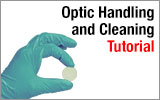
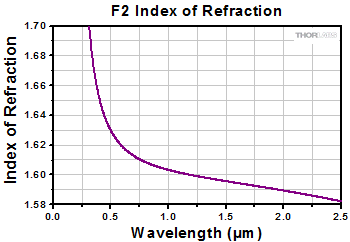

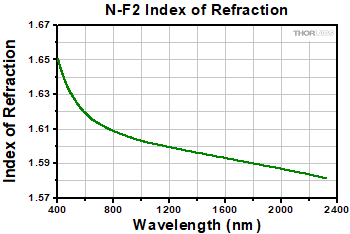
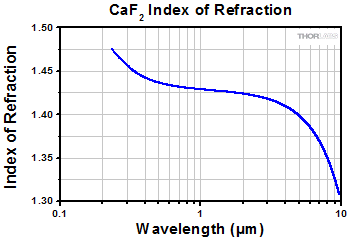
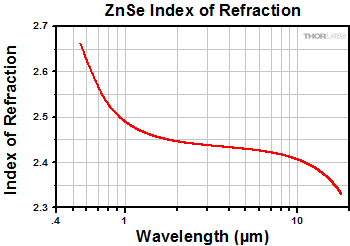
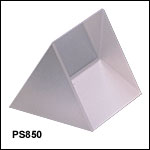
 Zoom
Zoom
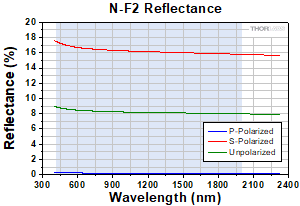
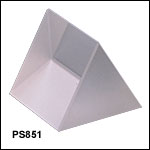
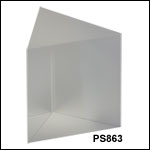
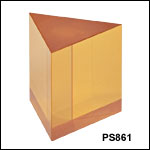
 Equilateral Dispersing Prisms
Equilateral Dispersing Prisms